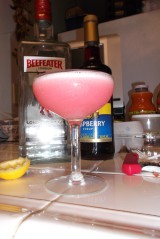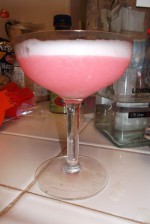Drink of the Week: The Clover Club (The Rasp-Wiki Take)
 If you have a deep aversion to déjà vu, I advise you to take a break from today’s and, yes, next week’s posts. (I haven’t decided yet about the week after that!)
If you have a deep aversion to déjà vu, I advise you to take a break from today’s and, yes, next week’s posts. (I haven’t decided yet about the week after that!)
You see, I’ve always been fascinated by how seemingly very small changes in cocktails can make very big differences. I also was, to be honest, fairly embarrassed to find out at close to the last minute last week that the Clover Club recipes I got from two bonafide cocktail book classics, Harry Craddock’s prohibition era Savoy Cocktail Book and Robert Hess’s vastly more recent The Essential Cocktail Guide, could be seen as minority takes on the drink.
It turned out that most of the presumably classic recipes I found online, such as the one featured on Wikipedia, suggested rather strongly that raspberry syrup, not grenadine, was the default sweetener/pinker-upper for this refreshing, too little known cocktail treat. I basically had to try this version out, and so we have today’s pinker, tangier take on the Clover Club.
What’s the difference between a little grenadine or a little raspberry syrup? I’ll tell you on the flip side.
The Clover Club (the Rasp-Wiki Take)
1 1/2 ounces gin
1/2-3/4 ounces fresh lemon juice
1 egg white
1/4 ounce raspberry syrup
Once again, we combine all the ingredients in a cocktail shaker, sans ice. Once again, we shake the luke-cool concoction to properly emulsify the egg. Once that’s done, we add some ice and shake again, very vigorously, to add much needed ice water to the mix. Then, it’s naturally time to strain the drink into a chilled cocktail glass. Our toast? How about to second (and third) chances?
******
So, which is better, the grenadine or the raspberry syrup iteration? If I had to choose, I think I’d go with last week’s grenadine. This raspberry adds a delightful tang I really enjoyed, but it was less sturdy in the sense it doesn’t really stand up to as much variation. Last week, I found my favorite version employed 3/4 of an ounce of lime juice although (a bit less) lemon juice was just fine. This time around, I’m counseling readers to skip the lime completely. For me at least, it just didn’t work. Lime juice has some additional flavors that just don’t blend with the raspberry.
My favorite version of this drink, however, did use the entire 3/4 ounce of lemon juice, which I suppose is odd given my tart-phobia. I’m guessing there’s something about the dryness of the lemon juice blending with the tangier raspberry-derived flavor. Ultimately, it’s a mystery.
And, speaking of mysteries, yes, will be trying another ever-so-slight variation of this week’s beverage next week. Next time around, we introduce something entirely new…a garnish! Stay tuned.
You can follow us on Twitter and Facebook for content updates. Also, sign up for our email list for weekly updates and check us out on Google+ as well.

 Sometimes the difference between one drink and another is miniscule. Take a
Sometimes the difference between one drink and another is miniscule. Take a  David Wondrich, there is a way to make this drink that makes it a thing of beauty and as pure and sweet as anything by East L.A.’s favorite sons, Los Lobos. It’s even better with an interesting tequila, but more about that in a bit.
David Wondrich, there is a way to make this drink that makes it a thing of beauty and as pure and sweet as anything by East L.A.’s favorite sons, Los Lobos. It’s even better with an interesting tequila, but more about that in a bit. It’s Oscar weekend and the modern day quasi-silent film, “The Artist” is looking to take many, if not most, of the little gold men. It’s therefore kind of hard think of a better selection than this delightfully subtle and sweet, if now obscure,
It’s Oscar weekend and the modern day quasi-silent film, “The Artist” is looking to take many, if not most, of the little gold men. It’s therefore kind of hard think of a better selection than this delightfully subtle and sweet, if now obscure,  The name of today’s DOTW notwithstanding, this post is not brought to you by the ongoing Republican primary or anything else happening in the world of U.S. or Latin American politics. Instead, we all should thank the good people of Denizen Rum. As always, I appreciate the free bottle but I also appreciate the very reasonable price tag for a fifth which, depending on taxes in your area, might give you enough change from a $20.00 for a Double-Double at In ‘n Out. That’s something because this is tasty stuff, a bit more sophisticated and complex than your standard Bacardi, but in the friendliest way.
The name of today’s DOTW notwithstanding, this post is not brought to you by the ongoing Republican primary or anything else happening in the world of U.S. or Latin American politics. Instead, we all should thank the good people of Denizen Rum. As always, I appreciate the free bottle but I also appreciate the very reasonable price tag for a fifth which, depending on taxes in your area, might give you enough change from a $20.00 for a Double-Double at In ‘n Out. That’s something because this is tasty stuff, a bit more sophisticated and complex than your standard Bacardi, but in the friendliest way.








